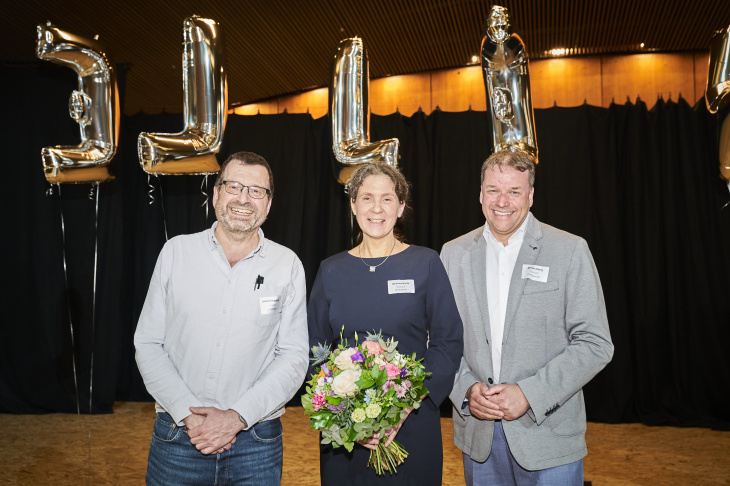Millions for CLICCS and BlueMat
Both the existing Cluster of Excellence CLICCS at Universität Hamburg (UHH) and the new Cluster BlueMat at Technische Universität Hamburg Harburg (TUHH) will receive up to 10 Euros a year in funding over the next seven years from 2026. This was announced yesterday in Bonn by the Deutsche Forschungsgemeinschaft and the German Wissenschaftsrat. The Helmholtz-Zentrum Hereon is involved in both Clusters.
Applause and cheers resounded in the lecture halls of the UHH and TUHH for a long time yesterday. The Cluster of Excellence CLICCS (“Climate, Climatic Change, and Society”) focuses on research into climate change and its social consequences. BlueMat (“Water-Driven Materials”) is concerned with materials whose functions are redesigned through the targeted use of water. A total of 70 Clusters across Germany will receive funding totaling more than half a billion euros.
CLICCS II conducts interdisciplinary research into climate change

The spokesperson of CLICCS, Prof Johanna Baehr, with the deputy spokespersons Prof Jochem Marotzke (left) and Prof Achim Oberg. In her speech, she emphasized that the work in the cluster was only possible in the special research environment of Hamburg with its many players in climate research. Photo: UHH/ Claudia Höhne
The future that awaits us depends not only on the climate system, but also on society - in other words, on how people will live, work and do business in the future. In the continuing Cluster of Excellence CLICCS II, researchers from the natural and social sciences will work closely together. Their approach: defining climate change and social development through two central measures - avoiding CO2 emissions and adapting to a changing climate. CLICCS derives scientifically sound decision-making aids for policymakers and develops effective climate measures in dialog with society.
In the Cluster, UHH conducts research together with twelve non-university partners, including Hereon. More than 200 scientists from 16 disciplines are currently working together. The current CLICCS Cluster of Excellence will be funded until the end of 2025, after which the CLICCS II research project will be launched.
Hereon's Scientific Director, Prof Regine Willumeit-Römer, comments on the continuation: “CLICCS was an early adopter of AI and is therefore an excellent fit with our strategy. The collaboration with CLICCS has contributed significantly to the development of our knowledge on climate change. We understand it better and anyone can find out about the current status through the climate services provided. I am therefore very pleased that our successful and fruitful cooperation is moving into the next phase.”
Website Uni Hamburg (UHH), Press Release
BlueMat turns water into more

Technische Universität Hamburg Harburg is now also responsible for a Cluster of Excellence. Photo: TUHH/ TastD
The newly approved BlueMat Cluster is a milestone for materials research in Germany: together with its partner institutions, the TUHH is focusing on an innovative research approach: giving materials a new function through the targeted use of water. Water is not only omnipresent, but also a tool for changing material properties. For example, they can produce energy, adjust light transmission and color, develop electromagnetic properties or change their flexibility. All of this is done using sustainable materials, which pave the way for innovative and environmentally friendly applications.
This suits Hamburg as an international, cosmopolitan city on the waterfront. The leading TUHH Cluster is supported by nine other partners, including Hereon. The close cooperation between the various institutions offers ideal conditions for scientific discoveries and their transfer into practice.
“In order to understand complex processes and systems, research across disciplines is an important key to success at Hereon. The fact that ten partners will be involved in BlueMat also shows how interdisciplinary work can be fantastically successful. Together, we will make greater use of the potential of water - for example for material properties that help generate and store energy. I am delighted that we can support this collaboration,” says Regine Willumeit-Römer about the new Cluster.
Website Technische Uni Hamburg Harburg (TUHH), Press Release
Excellence Strategy of the federal and state governments
With the Excellence Strategy, the federal and state governments want to strengthen Germany as a science location. The further development of universities is to be continued by promoting top performance, profile building and cooperation with non-university research institutions. The federal and state governments' competition for excellence takes place in two funding lines: The first is for Clusters of Excellence, which receive funding for seven years in each award. The second funding line is dedicated to Universities of Excellence, i.e. the awarding of prizes to entire universities.
Cutting-edge research for a changing world
Helmholtz-Zentrum Hereon`s scientific research aims at preserving a world worth living in. To this end, around 1000 employees generate knowledge and research new technologies for greater resilience and sustainability - for the benefit of the climate, the coast and people. The path from idea to innovation leads through a continuous interplay between experimental studies, modeling and AI to digital twins that map the diverse parameters of climate and coast or human biology in the computer. This is an interdisciplinary approach that spans from the fundamental scientific understanding of complex systems to scenarios and practical applications. As an active member of national and international research networks and the Helmholtz Association, Hereon supports politics, business and society in shaping a sustainable future by transferring the expertise it has gained.
